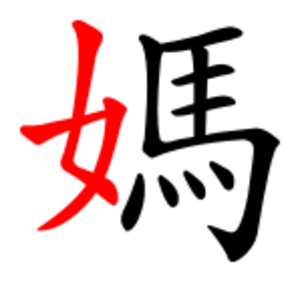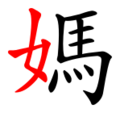Radical (Chinese characters) facts for kids
A Chinese radical (called bùshǒu in Chinese) is a special part of a Chinese character. Think of it like a main building block or a category label for characters in a dictionary. When you look up a Chinese character, you often find it listed under its radical.
Radicals often give you a hint about the character's meaning. For example, characters related to water might have the "water" radical, and characters related to trees might have the "tree" radical. Sometimes, a radical might even give a hint about the character's sound!
Contents
History of Radicals
Long ago, in the 2nd century AD, a Chinese scholar named Xu Shen created a dictionary called Shuowen Jiezi. He was the first to group Chinese characters by their shared parts. He picked 540 of these parts, which he called bù (meaning "categories"). Most of these were parts that gave a hint about the character's meaning. Each character was listed under just one of these parts, which we now call radicals. For example, all characters with the "female" radical (女) or the "tree" radical (木) were grouped together.
Later, in 1615, another dictionary by Mei Yingzuo made things even simpler. He cut the list of radicals down to 214. He also came up with a clever way to organize characters: first by their radical, and then by how many extra strokes the rest of the character had. This "radical-and-stroke-count" method is still used in most Chinese dictionaries today!
These 214 radicals became very famous when they were used in the Kangxi Dictionary in 1716. That's why they are often called the Kangxi radicals. Even though China has simplified its characters since then, these 214 radicals are still the main way characters are organized in many dictionaries.
Where Radicals Appear in Characters
Radicals can show up in different places within a character.
- The "female" radical (女) is usually on the left side, like in 姐 (older sister) or 媽 (mother). But sometimes it can be at the bottom, like in 妾 (concubine).
- Often, the part that hints at the meaning is on the top or left. The part that hints at the sound is usually on the right or bottom. But there are many exceptions!
- Sometimes, a radical can even wrap around other parts of the character, like the "enclosure" radical (囗) in 園 (garden).
Many character parts, including radicals, can change their shape a bit to fit into a character. They might become narrower or shorter. Sometimes, they even change their shape completely to have fewer strokes. The way a radical looks can depend on where it is placed in the character.
For example, the radical for "city" (邑) and "mound" (阜) both look like 阝 when they are part of another character. But if 阝 is on the right side, it's the "city" radical. If it's on the left side, it's the "mound" radical.
Here are some other common radicals that change shape:
- 刀 (knife) changes to 刂 when it's on the right side, like in 分 (divide).
- 人 (person) changes to 亻 on the left side, like in 他 (he/him).
- 心 (heart) changes to 忄 on the left side, like in 快 (fast).
- 手 (hand) changes to 扌 on the left side, like in 扡 (drag).
- 水 (water) changes to 氵 on the left side, like in 池 (pond).
- 火 (fire) changes to 灬 at the bottom, like in 黑 (black).
- 犬 (dog) changes to 犭 on the left side, like in 狙 (monkey).
Meaning and Sound Hints
Most Chinese characters (over 80%) are made of two main parts:
- A semantic component (often the radical) that gives a general idea of the character's meaning.
- A phonetic component that suggests how the character is pronounced.
So, when you see a character, its radical usually tells you what kind of thing or idea it's related to. For example, characters with the "wood" radical (木) are often related to trees, wood, or wooden objects.
Sometimes, a radical might even be used because it sounds similar to the character's pronunciation, even if its original meaning isn't directly related.
Simplified Characters and Radicals
In Mainland China, many Chinese characters were simplified. This changed how some radicals look. For example, the radical for "metal" (金) used to be written as 釒 when it was part of another character. But in simplified Chinese, it's written as 钅. This means that if you're learning simplified characters, you'll see a different form of this radical. For example, the character for "silver" is 銀 in traditional Chinese and 银 in simplified Chinese.
How to Look Up Characters in a Dictionary
Many Chinese dictionaries use radicals to help you find characters. Here's how it usually works: 1. Find the radical: Look at the character and try to guess which part is the radical. Often, it's the part on the left or at the top. 2. Go to the radical section: Dictionaries have a special section where all the radicals are listed. They are usually organized by how many strokes they have. 3. Count the extra strokes: Once you find the radical, count how many strokes are in the *rest* of the character (the part that's not the radical). 4. Find the character: In the radical's section, you'll find lists of characters organized by the number of extra strokes. Look for your character in the list that matches your stroke count.
Let's try an example: the character 信 (xìn), which means "truth" or "trust". 1. Its radical is 亻 (rén), which is a squeezed version of the "person" radical (人). 2. The "person" radical (人 or 亻) has only two strokes, so you'd find it near the beginning of the radical list. 3. The rest of the character (言) has seven strokes. 4. So, you would go to the "person" radical section and then look through the characters that have seven additional strokes until you find 信.
Sometimes, a character might be listed under more than one radical. For example, the character 義 might be found under the "sheep" radical (羊) or the "dagger-axe" radical (戈).
Modern digital dictionaries make this much easier! You can often draw the character with your mouse or finger, or even search by typing in several of its parts. This takes away the guesswork of finding the right radical and counting strokes.
Different Numbers of Radicals
Even though radicals are super helpful for organizing Chinese characters, not everyone agrees on the exact number of them. The 214 Kangxi radicals are like a standard, and most dictionaries use them as a base. However, some modern dictionaries might have fewer radicals (like 188) to make things simpler.
Today, radicals are mostly used as tools to help you look up characters and learn how to write them. They are still very important for anyone studying Chinese!
Images for kids
See also
 In Spanish: Radical (sinograma) para niños
In Spanish: Radical (sinograma) para niños
| Language | Characters |
|---|---|
| Chinese language | Hanzi |
| Japanese language | Kanji |
| Korean language | Hanja |
| Vietnamese language | Hán tự and Chữ Nôm |



